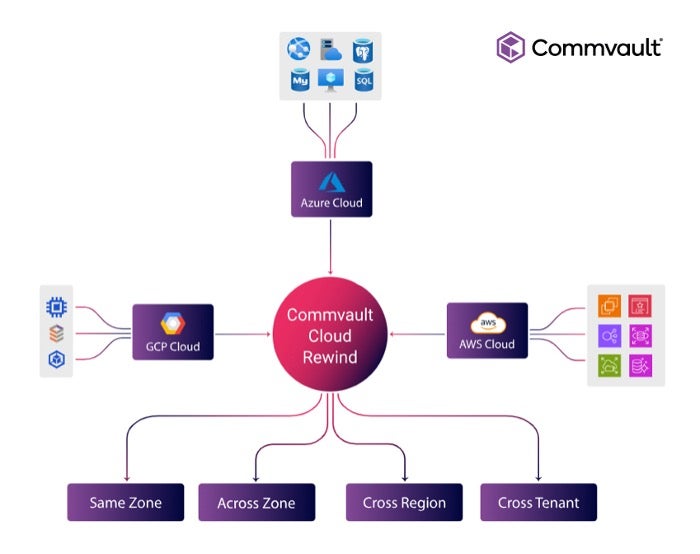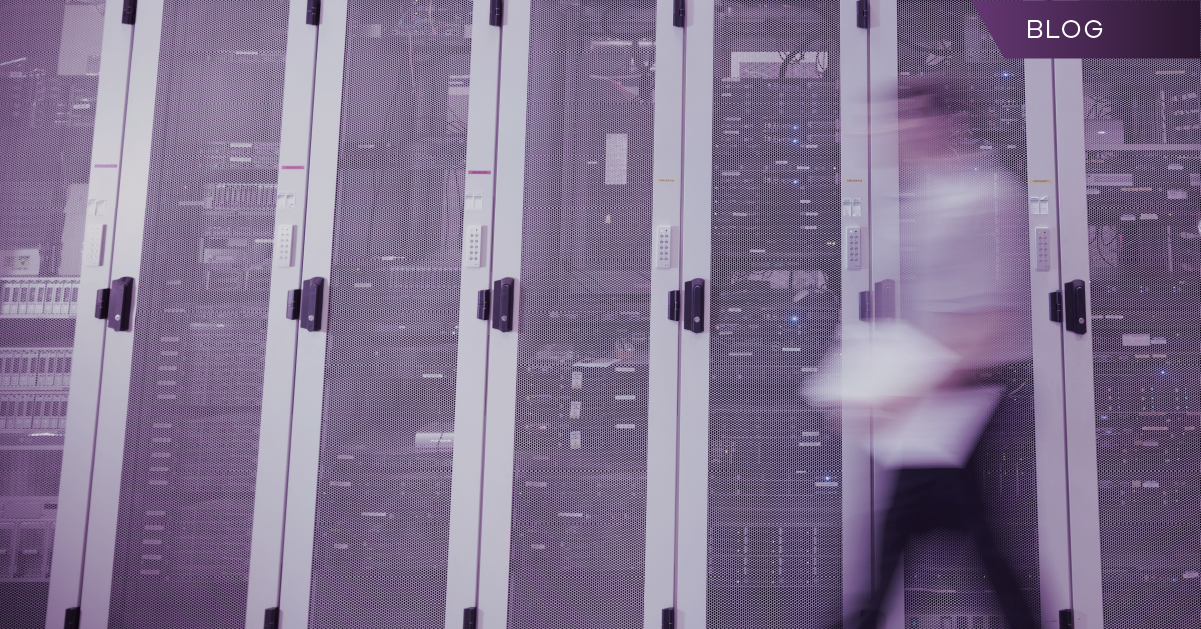The global shift toward cloud-native architectures has redefined what it means to achieve security and resilience. Cloud environments are dynamic by design; resources are frequently updated, added, or removed; applications stretch across regions and multi-clouds; and infrastructure evolves faster than most recovery tools can track. Traditional backup models, built for static systems, struggle to keep up with this pace and complexity.
Commvault Cloud Rewind™ is built from the ground up to handle this new reality. With an architecture purpose-built for cloud-scale recovery, Cloud Rewind helps you restore entire cloud environments, including applications and their dependencies, with ease.
This becomes essential in modern environments where applications are composed of microservices, containers, and serverless components that are often ephemeral and spread across multiple platforms.
Resources may change daily, and ownership is often decentralized across teams. Configuration drift, inconsistent change management, and the growing use of third-party services all make recovery harder. Even when manual backups are available, critical infrastructure metadata is often missing, making restorations unreliable or incomplete.
In this ecosystem, Cloud Rewind brings order to the chaos. By leveraging ongoing discovery, orchestration, and cloud-native operations, it provides fast and consistent recoverability. Whether you’re dealing with a simple misconfiguration or a full-blown cyberattack, Cloud Rewind helps restore critical resources in minutes.
A Deep Dive Into the Design: The Cloud Rewind Architecture
At the heart of Cloud Rewind are key architectural principles that prioritize automation, scalability, and recovery precision. From that foundation, it allows an integrated approach to help discover, protect, recover, and rebuild applications and data within cloud environments.
Cloud Rewind brings together powerful capabilities to strengthen cyber resilience and simplify recovery across cloud environments. Each feature plays an integral role in improving confidence in day-to-day operations and crisis response.
- Cloud discovery and dependency mapping: Cloud Rewind automatically discovers all relevant cloud resources and captures the metadata needed for accurate and repeatable recovery. This includes complete configuration settings, dependencies, and infrastructure details.
- Drift analysis: Cloud environments change rapidly. Cloud Rewind tracks these changes with regular drift analysis, comparing current configurations to known protected states. This keeps security teams informed about any deviations from expected configurations, helping maintain crucial alignment.
- Automated daily cloud rebuilds: Reverting to a safe state is not enough; it has to be done quickly and without errors. Cloud Rewind helps enable this with automated recovery testing. You can rebuild entire cloud infrastructures, applications, and data using on-demand environments. These temporary environments can later be deleted to help reduce testing costs.
- Integrated cyber recovery: Cloud Rewind works with Commvault’s broader data resilience platform, effectively combining backup, recovery, and threat intelligence. This unified approach provides better control and coordination during security incidents, helping teams move from detection to full recovery with speed and clarity.

Conquering the Competition: Where Cloud Rewind Stands Out
With a plethora of advanced features tailored for modern cloud-based organizations, Cloud Rewind provides effective and simplified recovery. While several industry solutions offer simple disaster recovery for cloud workloads, these capabilities help Cloud Rewind stand apart.
Cloud Rewind takes recovery resilience to the next level with:
- Broad multi-cloud coverage, with native support for AWS, Azure, and GCP.
- Full-stack resource coverage, including compute, storage, networking, IAM, DNS, containers, and serverless services.
- Detailed infrastructure metadata protection, using a dual-vault time machine.
- Explicit application dependency graphs, not just resource-level awareness.
- Recovery-as-Code, for orchestrated, code-driven recovery.
- Continuous validation, using regular automated rebuilds in isolated cloud spaces.
- Low operational burden, with high transparency through a SaaS delivery model.
Cloud Rewind combines protection, intelligence, and automation to support fast and reliable recovery across complex cloud environments. This helps Cloud Rewind stand out in a competitive field and stay ahead.
Cloud Resilience for Complete Cloud Workload Recovery
Commvault Cloud Rewind is built for full-stack cloud resilience, offering protection for modern, cloud-native workloads. Instead of simply backing up isolated resources, capturing and recovering entire cloud applications, referred to as Cloud Assemblies.
Cloud Rewind supports a wide range of cloud-native services, including virtual machines, disks, gateways, security groups, VPCs, DBaaS platforms, and containerized workloads. Once a cloud connection is established, Cloud Rewind performs automated identification of all resources in an environment. At scale, this can be highly significant. For one Commvault customer, 94,237 resources were discovered, with 7,811 protected resources organized into 19 distinct assemblies.
For complete protection, customers can begin with the definition of policies tailored to their Cloud Assemblies. These policies govern snapshot frequency, retention rules, and replication preferences. Snapshots can be taken as frequently as every 15 minutes or as infrequently as annually, depending on the workload’s recovery objectives. These snapshots can be used for rapid, point-in-time backups and fast rehydration.
With its sophisticated use of only cloud snapshots, Cloud Rewind offers protection at a fraction of the cost of expensive traditional high-availability or read‑replica architectures. As dedicated standby infrastructure isn’t required, customers pay only for snapshot storage and temporary compute during recovery operations. This flexibility allows customers to effectively fine-tune protection schedules to balance RPO requirements against storage costs.
Finally, Cloud Rewind provides cloud data resilience by performing recovery at the Cloud Assembly level. When it’s time to restore, Cloud Rewind can recreate the complete application, including the resource configurations, network settings, and dependencies, exactly as it existed at any point in time. Recovery also can target the original region for a quick rollback or be redirected to a different region, subscription, or project to support disaster recovery use cases.
By centering recovery around customer applications, Cloud Rewind replaces traditional complexity with invaluable clarity. With automated discovery, flexible policies, and cost‑effective snapshot-based protection, Cloud Rewind can help customers meet stringent recovery objectives while minimizing infrastructure overhead.
A New Era of Resilience: Key Advantages of Cloud Rewind
Cloud Rewind introduces a new standard for resilience in the cloud, shifting away from legacy disaster recovery models toward an approach designed for dynamic, modern environments. By focusing on full application recovery instead of isolated resources, it helps avoid downtime, reduce operational risks, and support rapid, coordinated recovery and restoration across cloud platforms.
One of its core innovations is the patented dual-vault cloud time machine. This unique approach protects immutable vaults in different hyperscale clouds for rapid application recoveries. This design not only defends against failures and cyber threats but also enables precise, point-in-time recovery of entire application environments.
With a myriad of powerful capabilities that support the growth of modern businesses, Cloud Rewind makes an impact:
- Financial service entities leverage Cloud Rewind to help you meet stringent regulatory requirements while minimizing downtime for real-time financial systems.
- Healthcare organizations use Cloud Rewind to help you rapidly recover electronic health records and other critical applications during cyber incidents, preventing the disruption of patient care.
- In the education sector, Cloud Rewind provides a safety net, enabling protection against the loss of courseware, student data, and other resources.
- Retail and manufacturing businesses leverage Cloud Rewind to quickly recover from outages or cyberattacks, leading to minimization of revenue loss and continuation of production schedules.
- Technology and SaaS providers use Cloud Rewind to help you protect cloud-native platforms and deliver continuous service to customers.
Across sectors, Cloud Rewind is delivering measurable results. So, prominent real-world cases of organizations benefitting from this innovative solution have promptly emerged.
The Boston-based EdTech company Pragya Systems’ SaaS resiliency increased by a staggering 300% with Cloud Rewind. Similarly, backed by the powerful capabilities of Cloud Rewind, an eDiscovery leader recovered from a major ransomware attack.
Looking at the financial services sector, a top mortgage lending entity decreased cloud application resilience cost by 85% with Cloud Rewind. Finally, leveraging Cloud Rewinds’ app-centric BCDR approach, a global cloud solutions provider achieved a 99.9% cloud app resilience SLA.
Cloud Recovery Like Never Before
Commvault Cloud Rewind represents a turning point in the way organizations approach resilience. Instead of relying on fragmented tools or rigid recovery processes, Cloud Rewind provides a cloud-native architecture that keeps pace with change. With deep automation, application-centric recovery, and proven results across industries, it empowers organizations to protect what matters, recover faster, and operate with confidence.


